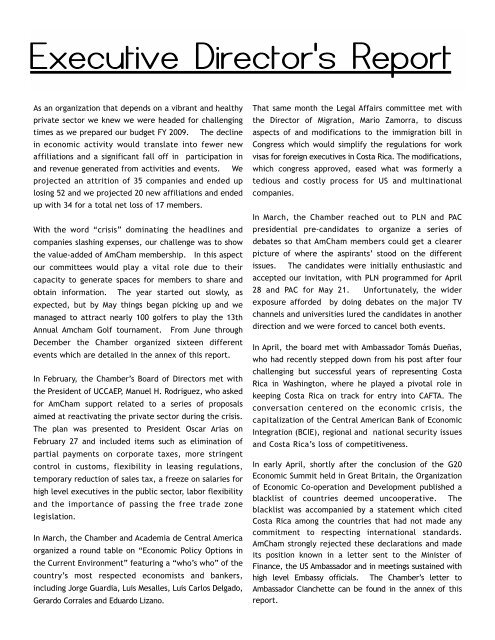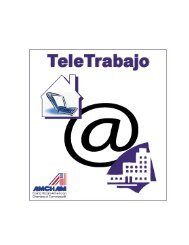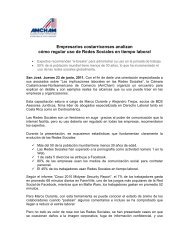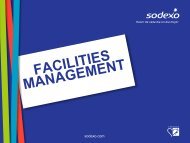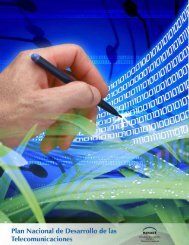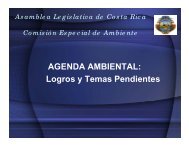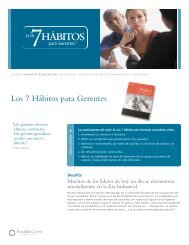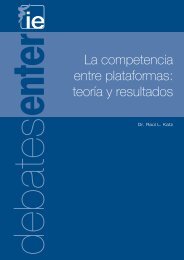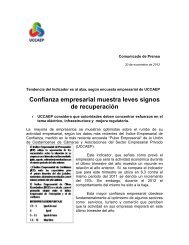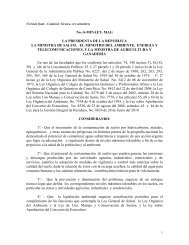Reporte Anual 2009 - Amcham
Reporte Anual 2009 - Amcham
Reporte Anual 2009 - Amcham
You also want an ePaper? Increase the reach of your titles
YUMPU automatically turns print PDFs into web optimized ePapers that Google loves.
Executive Director's ReportAs an organization that depends on a vibrant and healthyprivate sector we knew we were headed for challengingtimes as we prepared our budget FY <strong>2009</strong>. The declinein economic activity would translate into fewer newaffiliations and a significant fall off in participation inand revenue generated from activities and events. Weprojected an attrition of 35 companies and ended uplosing 52 and we projected 20 new affiliations and endedup with 34 for a total net loss of 17 members.With the word “crisis” dominating the headlines andcompanies slashing expenses, our challenge was to showthe value-added of AmCham membership. In this aspectour committees would play a vital role due to theircapacity to generate spaces for members to share andobtain information. The year started out slowly, asexpected, but by May things began picking up and wemanaged to attract nearly 100 golfers to play the 13thAnnual <strong>Amcham</strong> Golf tournament. From June throughDecember the Chamber organized sixteen differentevents which are detailed in the annex of this report.In February, the Chamber’s Board of Directors met withthe President of UCCAEP, Manuel H. Rodriguez, who askedfor AmCham support related to a series of proposalsaimed at reactivating the private sector during the crisis.The plan was presented to President Oscar Arias onFebruary 27 and included items such as elimination ofpartial payments on corporate taxes, more stringentcontrol in customs, flexibility in leasing regulations,temporary reduction of sales tax, a freeze on salaries forhigh level executives in the public sector, labor flexibilityand the importance of passing the free trade zonelegislation.In March, the Chamber and Academia de Central Americaorganized a round table on “Economic Policy Options inthe Current Environment” featuring a “who’s who” of thecountry’s most respected economists and bankers,including Jorge Guardia, Luis Mesalles, Luis Carlos Delgado,Gerardo Corrales and Eduardo Lizano.That same month the Legal Affairs committee met withthe Director of Migration, Mario Zamorra, to discussaspects of and modifications to the immigration bill inCongress which would simplify the regulations for workvisas for foreign executives in Costa Rica. The modifications,which congress approved, eased what was formerly atedious and costly process for US and multinationalcompanies.In March, the Chamber reached out to PLN and PACpresidential pre-candidates to organize a series ofdebates so that AmCham members could get a clearerpicture of where the aspirants’ stood on the differentissues. The candidates were initially enthusiastic andaccepted our invitation, with PLN programmed for April28 and PAC for May 21. Unfortunately, the widerexposure afforded by doing debates on the major TVchannels and universities lured the candidates in anotherdirection and we were forced to cancel both events.In April, the board met with Ambassador Tomás Dueñas,who had recently stepped down from his post after fourchallenging but successful years of representing CostaRica in Washington, where he played a pivotal role inkeeping Costa Rica on track for entry into CAFTA. Theconversation centered on the economic crisis, thecapitalization of the Central American Bank of EconomicIntegration (BCIE), regional and national security issuesand Costa Rica’s loss of competitiveness.In early April, shortly after the conclusion of the G20Economic Summit held in Great Britain, the Organizationof Economic Co-operation and Development published ablacklist of countries deemed uncooperative. Theblacklist was accompanied by a statement which citedCosta Rica among the countries that had not made anycommitment to respecting international standards.AmCham strongly rejected these declarations and madeits position known in a letter sent to the Minister ofFinance, the US Ambassador and in meetings sustained withhigh level Embassy officials. The Chamber’s letter toAmbassador Cianchette can be found in the annex of thisreport.


